By Zevan | February 5, 2009
Actionscript:
-
var cmds:Array = [["lineStyle", 0, 0xFF0000], ["drawCircle",100, 100, 50], ["drawRect", 50, 50, 100, 100]];
-
cmds.push(["drawCircle", 100, 100, 70]);
-
cmds.push(["beginFill", 0x555555]);
-
cmds.push(["drawRoundRect", 80, 80, 40, 40, 10, 10]);
-
cmds.push(["endFill"]);
-
-
render(cmds);
-
-
function render(p:Array):void {
-
for (var i:int = 0; i<p.length; i++) {
-
graphics[p[i][0]].apply(graphics,p[i].splice(1));
-
}
-
}
The above creates a function called render() that takes a 2D array of Graphics class methods and then runs them. This is a very interesting technique, specifically if you'd like to write Graphics class method calls in an XML or txt file and then have them run on a given DisplayObject in flash.
I've been thinking about the best way to do this for awhile... I started off doing something very convoluted and then realized that I could use Function.apply()....
Tomorrow I'll post a snippet showing how to use this function in conjunction with XML.
Posted in Graphics, dynamic, functions | Also tagged flash |
By Zevan | February 4, 2009
Actionscript:
-
[SWF(width=900,height=390,backgroundColor=0x000000,frameRate=30)]
-
-
var canvas:BitmapData=new BitmapData(4,8,false,0xFFFFFFFF);
-
var pixNum:int = canvas.width * canvas.height;
-
-
var frame:Bitmap = Bitmap(addChild(new Bitmap(canvas)));
-
frame.scaleX = frame.scaleY = canvas.width * 10;
-
frame.x = stage.stageWidth / 2 - frame.width / 2;
-
frame.y =20;
-
-
var txt:TextField = TextField(addChild(new TextField()));
-
txt.autoSize = TextFieldAutoSize.LEFT;
-
txt.defaultTextFormat = new TextFormat("Verdana", 8, 0xFFFFFF);
-
txt.x = frame.x - 3;
-
txt.y = frame.y + frame.height + 10;
-
-
var s:String, a:Number = 0, d:Number = 0;
-
var r:Number = 0xFFFFFFFF / (stage.stageWidth-20) ;
-
-
addEventListener(Event.ENTER_FRAME, onLoop);
-
function onLoop(evt:Event):void {
-
a += (d - a) / 8;
-
-
d = (mouseX-10) * r;
-
-
s = Math.max(0,Math.min(0xFFFFFFFF, a)).toString(2);
-
-
if (s.length <pixNum){
-
while(s.length-1 <pixNum){
-
s = "0" + s;
-
}
-
}
-
-
txt.text = s;
-
-
canvas.lock();
-
canvas.fillRect(canvas.rect, 0xFFFFFF);
-
for (var i:int = 0; i<pixNum; i++){
-
if (s.charAt(i) == "0"){
-
canvas.setPixel(i % 4, i / 4, 0x000000);
-
}
-
}
-
canvas.unlock();
-
}
Similar to yesterdays post... this snippet visualizes binary numbers. Move your mouse left and right to change the value of the number that's being displayed.
Here are a few stills:
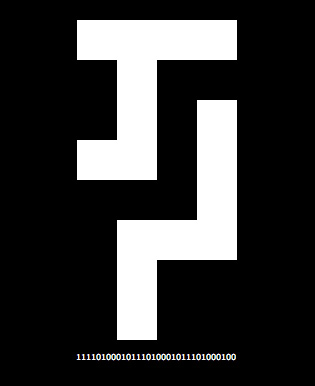
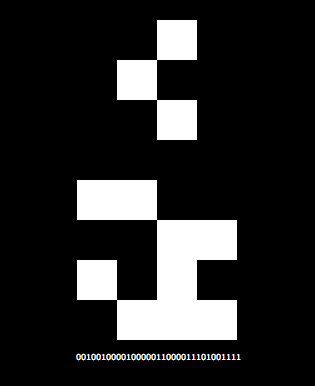
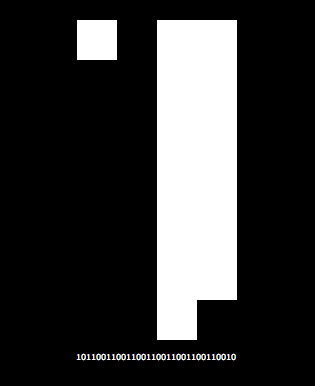
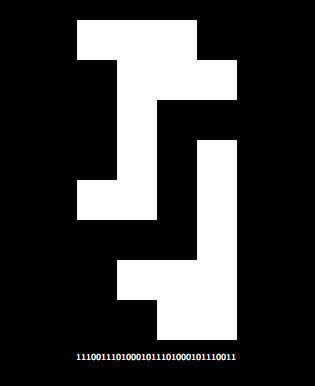
This code uses the mouse position to choose which binary number to display. Going all the way to the left of the screen will set this number to 0 and going all the way to the right will set it to 4294967295... that number may look arbitrary unless you see it in in binary 11111111111111111111111111111111 or in hexadecimal 0xFFFFFFFF.
Posted in BitmapData, setPixel | Also tagged flash |
By Zevan | February 3, 2009
Actionscript:
-
[SWF(width=320,height=512,backgroundColor=0x000000,frameRate=30)]
-
-
var canvas:BitmapData=new BitmapData(32,512,false,0xFFFFFF);
-
addChild(new Bitmap(canvas)).scaleX = 10;
-
-
var a:uint ;
-
var s:String;
-
var m:Number = 0;
-
var d:Number = 0;
-
var mi:int ;
-
var r:Number = 0xFFFFFF / stage.stageWidth;
-
-
addEventListener(Event.ENTER_FRAME, onLoop);
-
-
function onLoop(evt:Event):void {
-
-
d = mouseX * r;
-
m += (d - m) / 30;
-
-
mi = int(m);
-
-
canvas.lock();
-
canvas.fillRect(canvas.rect, 0xFFFFFF);
-
-
a = 0xFFFFFFFF;
-
for (var i:int = 0; i<512; i++) {
-
s = (a -= mi).toString(2);
-
for (var j:int = 0; j<s.length; j++) {
-
if (s.charAt(j)=="0") {
-
canvas.setPixel(j, i, 0x000000);
-
}
-
}
-
}
-
canvas.unlock();
-
}
The above uses setPixel() to visualize numbers in binary format. You can move your mouse left and right to change an incremental counting value....
Here's a still generated by this snippet:
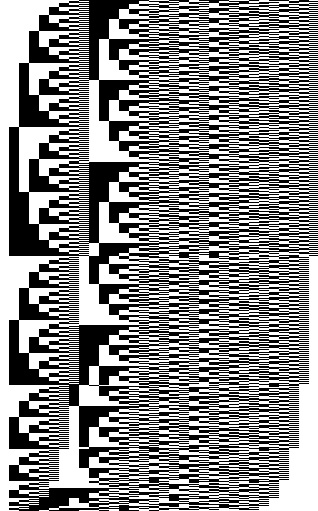
By Zevan | February 2, 2009
Actionscript:
-
package {
-
import adobe.utils.*;
-
import flash.accessibility.*;
-
import flash.display.*;
-
import flash.errors.*;
-
import flash.events.*;
-
import flash.external.*;
-
import flash.filters.*;
-
import flash.geom.*;
-
import flash.media.*;
-
import flash.net.*;
-
import flash.printing.*;
-
import flash.profiler.*;
-
import flash.sampler.*;
-
import flash.system.*;
-
import flash.text.*;
-
import flash.ui.*;
-
import flash.utils.*;
-
import flash.xml.*;
-
-
dynamic public class Snippet extends MovieClip {
-
public function Snippet() {
-
// paste your snippet here (functions and all)
-
}
-
}
-
}
This snippet imports all flash packages and is dynamic... you can copy actionsnippet code into the constructor of this file if you use Flex, FlashDevelop, TextMate etc... I tested it with a bunch of snippets and it seems to work nicely.
When I first teach classes in AS3 this is the template I use:
Actionscript:
-
package{
-
import flash.display.*;
-
import flash.events.*;
-
-
public class Main extends Sprite{
-
// etc...
-
}
-
}
Display and events cover a lot of ground..... next one I find myself adding is flash.geom, followed by flash.net... I'd say those are my top 4 most frequently used packages.... I do lots of text layout in the Flash IDE, otherwise flash.text would be in there....
Posted in OOP, dynamic, misc, timeline | Also tagged flash |




